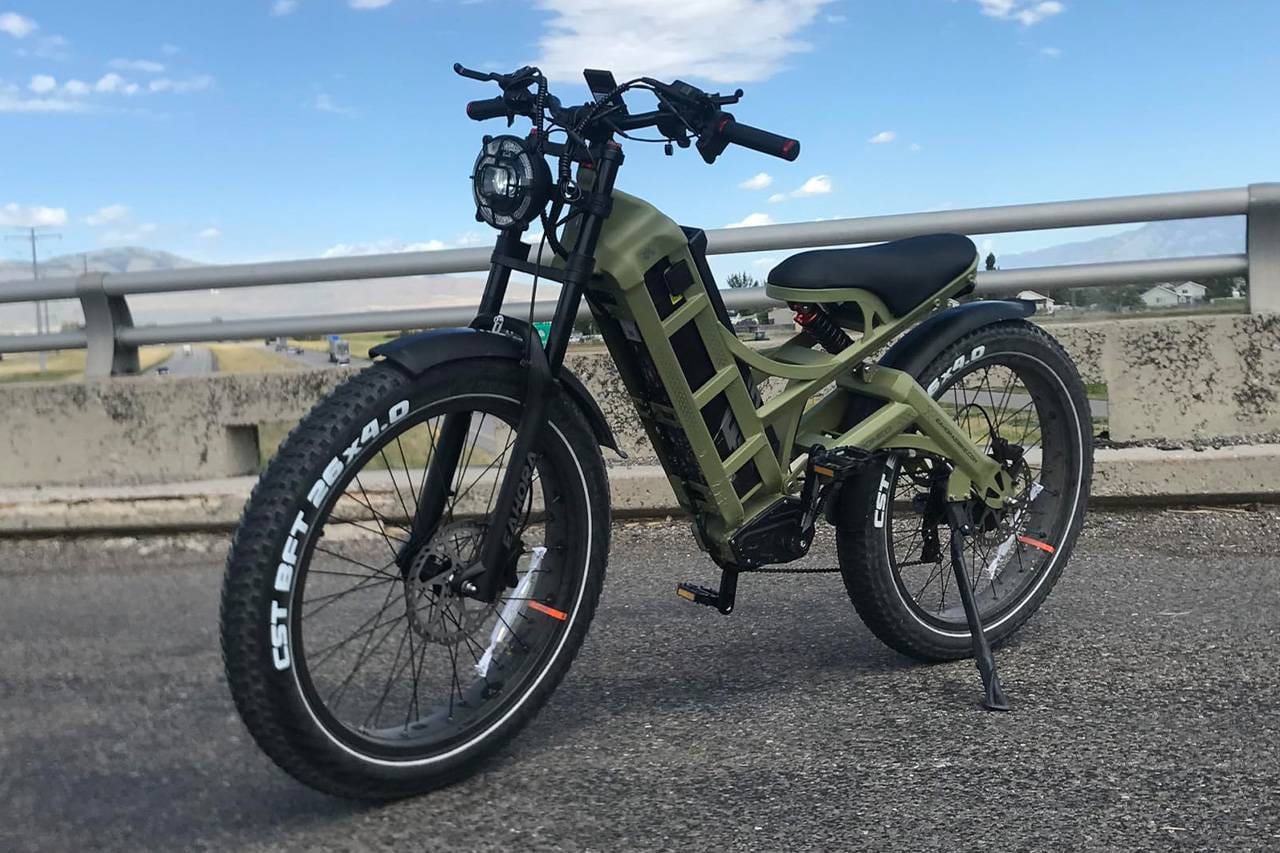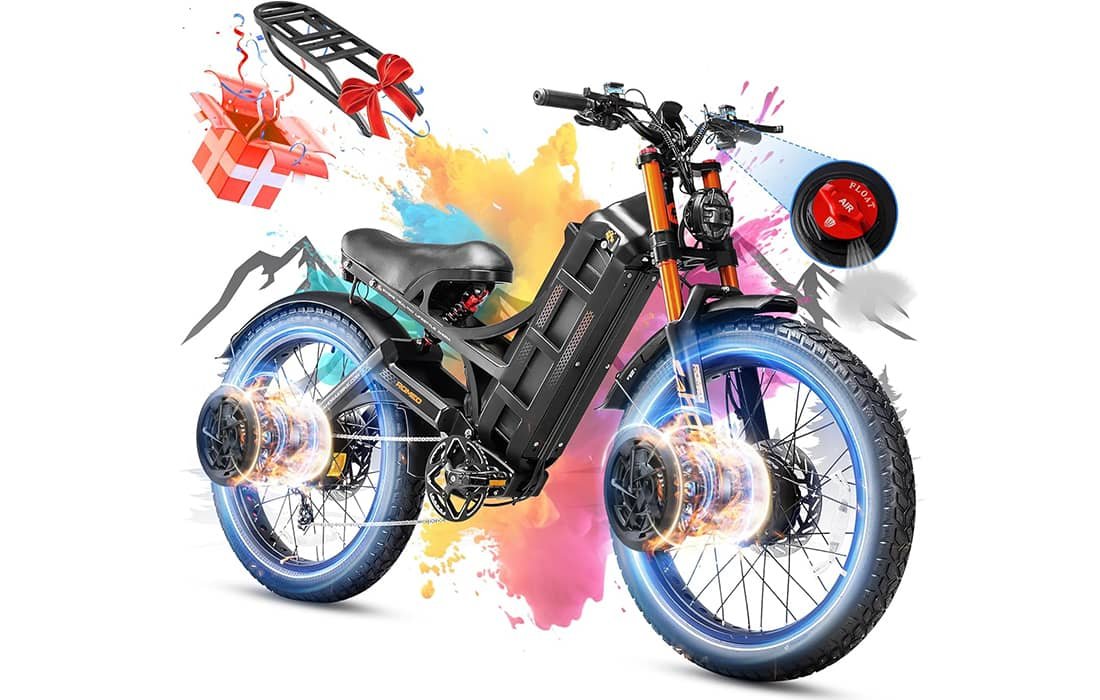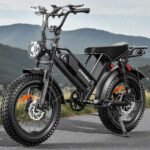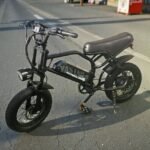

eAhora Romeo Pro II – Ultra Long-Range Dual-Motor Ebike
Our take: a true e-moto for riders who want 46 mph speed, huge 52V 70Ah range and full-suspension comfort for commuting, delivery and adventure.
- 4000W dual hub motors rocket to 46 mph and crush steep 45° climbs when you need maximum power.
- Massive 52V 70Ah battery delivers true long-range riding for commuting, delivery and weekend trips.
- Full suspension, 26×4.0″ fat tires, 500 lb payload and smart APP control for safer all-terrain rides.
- Motor
- 4000W dual hub (2×2000W)
- Battery
- 52V 70Ah (≈3640 Wh)
- Top Speed
- Up to 46 mph
- Range
- Up to 200+ mi (PAS)
The eAhora Romeo Pro II is not a typical commuter e-bike. It’s a full-on electric moped with pedals, built around a monster 52V 70Ah battery and dual 2000W hub motors. On paper it promises 46 mph top speed, 200+ miles of range, and the ability to carry up to 500 lb while floating over rough roads on full suspension and 4-inch fat tires.
That combination makes the Romeo Pro II one of the most extreme production “bikes” you can currently buy. It also means it won’t be for everyone. The massive frame, motorcycle-like weight, and off-road level power put it firmly in the “high-performance e-moto” category rather than a casual urban cruiser.
If you’re considering this bike for long-distance commuting, food delivery, or weekend adventures, this in-depth review will walk through how it actually stacks up on power, range, comfort, safety, and day-to-day practicality.
Quick Verdict
The eAhora Romeo Pro II is best described as a small electric motorcycle that still has pedals. The dual-motor setup, gigantic 52V 70Ah (roughly 3.6 kWh) battery and stout steel frame transform it into a serious machine for riders who value power and range over light weight and nimble handling.
In the right hands, it’s a fantastic tool: long-distance commuters, food-delivery riders, and adventure seekers can cover 70–120+ real-world miles per charge without babying the throttle, while still having enough power to sprint to 40+ mph when needed. However, the same things that make it special—speed, weight, and motorcycle-like stance—also mean it’s overkill for casual path riding and may not be street-legal as a “bicycle” in many regions.
Romeo Pro II at a Glance
- Motor system: Dual hub motors, 2000W each (4000W peak combined), up to 120 Nm x2 torque
- Battery: 52V 70Ah removable pack (≈3640 Wh), BMS protection, fast 58.8V 7A charger
- Claimed range: Up to ~200 miles with pedal assist; 70–76 miles on throttle only (factory figures)
- Top speed: 41–46 mph in unrestricted dual-drive mode
- Frame & fork: Thickened high-carbon-steel frame, custom dual-crown air/oil/coil front fork, rear shock with rebound adjustment
- Brakes: Dual hydraulic disc brakes with dual oil cups and oversize 240 mm x 3.0 mm rotors
- Tires: 26" x 4.0" all-terrain fat tires (20" x 4.5" variant available on some listings)
- Weight & payload: Roughly 150–160 lb complete; rated payload up to 500 lb
- Rider fit: Recommended for riders around 5'7"–6'4"
- Price (list): $2,699.99 (often discounted)
Highlights
- Explosive acceleration and serious hill-climbing from dual motors
- One of the largest stock batteries on any single-battery e-bike right now
- Full-suspension chassis tuned specifically for a heavy dual-motor platform
- Big 240 mm hydraulic brakes with dual oil cups for repeated high-speed stops
- 360° light system, 2000-lumen headlight and UL-related electrical safety focus (UL2849 claimed)
- Smartphone app with navigation, bike positioning, error codes, and ride records
Potential Dealbreakers
- Very heavy and bulky; not apartment-friendly or easy to lift onto racks
- Overpowered for typical bike paths and may not be legal as a Class 1–3 bike in many areas
- Requires respect and rider skill; not ideal as a first e-bike
- Single fixed-height moto saddle with limited fit adjustability
- Real-world range can still fall short of the marketing 200-mile headline if you ride fast and use dual-motor mode most of the time
Bottom line: If you want a high-speed, long-range electric moped for commuting, delivery, or adventure, and you’re comfortable handling a 150+ lb machine, the Romeo Pro II is one of the most capable dual-motor fat-tire e-bikes currently available. If you just need an efficient city bike, it’s far more than you need.
What Is the eAhora Romeo Pro II?
The Romeo family is eAhora’s line of moped-style, long-range fat-tire e-bikes. Earlier Romeo models were already powerful, but the Romeo Pro II (often referred to as the 2025 version) turns everything up: more motor, more battery, beefier frame, and bigger brakes.
Rather than chasing lightweight efficiency, eAhora built the Pro II around a massive pouch-cell battery and dual-drive power system. That makes it attractive to riders who:
- Travel long distances daily for work or commuting
- Carry heavy loads or occasionally a second rider
- Want motorcycle-like performance without jumping all the way to a full-size motorcycle
Stylistically it’s pure e-moto: long seat, dual-crown fork, boxy central battery, 26 x 4.0 tires, and upright bars. The pedals are functional—for legal classification and for stretching range—but this is not a traditional pedal-first mountain bike. It’s very much a motor-first machine with bicycle controls.
Key Specs
| Feature | Specification* |
|---|---|
| Motor | Dual hub motors, ~2000W each (4000W peak combined), up to 120 Nm ×2 torque |
| Battery | 52V 70Ah removable lithium battery (≈3640 Wh), BMS safety protection |
| Controller | Dual 60V 36Ah controllers, up to 120°C heat resistance |
| Top Speed | 41–46 mph (PAS or throttle, in performance mode) |
| Claimed Range | 104–200 miles PAS, 70–76 miles throttle-only (ideal conditions) |
| Frame | High-carbon-steel “moto” frame, thickened weld areas, 500 lb payload rating |
| Suspension | Custom dual-crown air/oil/coil front fork + adjustable rear shock |
| Brakes | Dual hydraulic disc, dual oil cups, 240 mm × 3.0 mm rotors |
| Drivetrain | Shimano 7-speed derailleur |
| Tires | 26" × 4.0" fat tires (all-terrain tread) |
| Lighting | 360° light system: 2000-lumen headlight, brake taillight, tire reflectors |
| Assist Modes | 5 PAS levels, throttle, cruise control, 6 km/h walk mode, front / rear / dual drive selection |
| App Features | Navigation, Bluetooth positioning, ride records, system health, fault codes |
| Certification | UL 2849 electrical system claimed, IPX6–IPX65 water resistance |
| Bike Weight | ~150–161 lb including battery (varies by listing) |
| Rider Height | Recommended ~5'7"–6'4" |
| Max Load | Up to 500 lb |
*Specs can vary slightly between retailers and production batches; always double-check your specific listing.
Who Is the eAhora Romeo Pro II Best For?
Ideal For
- Long-distance commuters: If you regularly do 20–40 miles each way, the Romeo Pro II gives enough range to do round-trips with margin, even at higher speeds.
- Food delivery & courier work: Huge battery capacity, good lighting, and strong brakes make it appealing for Doordash, Uber Eats, or local courier riding, especially in hilly cities.
- Adventure & camping: Full suspension, 4-inch tires, and dual motors give you the confidence to tackle forest roads, fire trails, and rough backroads while still having plenty of battery to get home.
- Heavy riders & cargo: With a 500 lb load rating and thickened frame, it’s one of the few e-bikes comfortable carrying a large rider plus gear.
Not Ideal For
- Total beginners: The speed and sheer mass leave little room for mistakes. New riders are better off on a 750–1000W hardtail before jumping into something this powerful.
- Tight urban environments with stairs: At around 150+ lb, you don’t want to carry this up to a 4th-floor walk-up or constantly lift it into a car trunk.
- Strict Class 1–3 regions: In many places, a 4000W, 46 mph bike is not legally an “e-bike.” If you live somewhere with strict enforcement, you may need to treat it as a moped or motorcycle and register it accordingly.
Budget & Value
At a list price of $2,699.99 (and often lower during sales), the Romeo Pro II sits in the same price class as many premium single-motor fat-tire bikes that have far smaller 52V 15–20Ah batteries and standard 750W motors. When you divide the cost by watt-hours, it’s actually very competitive: you’re paying slightly above average e-bike money for far more battery and motor hardware than usual.
The real value comes if you actually use the power and range. If your riding is mostly 10 km to the coffee shop and back, this is money wasted. If you’re piling on 100+ miles per week and relying on the bike for work or long exploration, it starts to make real financial sense compared with gas or public transport.
Design, Frame & Build Quality
The Romeo Pro II’s frame is built like a small motorcycle. eAhora uses a thickened high-carbon-steel frame with wider welds and additional bracing around the battery cradle and motor mounts. Marketing materials claim +30% welding smoothness and 100% X-ray inspection of welds, which is unusual for this price point and suggests they’re taking structural integrity seriously for the 500 lb payload rating.
The look is unapologetically aggressive:
- Moto-style top frame and saddle: A long, one-piece saddle sits on a solid rear subframe, giving riders room to slide forward and back or occasionally carry a passenger (where legal).
- Central battery box: The large 52V 70Ah pack sits vertically in the middle of the frame, protecting it from impacts and keeping the weight low and central.
- Dual-crown front fork: The custom eAhora fork visually ties the bike to downhill mountain bikes and small dirt bikes.
- Integrated rear light and reflectors: The 360° lighting and reflective sidewalls help such a dark, stealthy frame stay visible at night.
Cable routing is reasonably tidy for a dual-motor bike—there’s only so much you can do with two motor leads, brake hoses, and wiring harnesses—but nothing feels fragile or slapped together. Fenders are full-coverage plastic/metal hybrids that should hold up to rainy commuting and gravel spray.
Fit and finish vary by batch like many direct-to-consumer brands, but overall, photos and owner comments suggest welds are neat, paint is consistent, and the bike looks and feels more expensive than its price once assembled.
Motor Performance & Speed
The headline feature here is the dual-motor system. eAhora pairs two high-torque DC hub motors (nominally ~2000W each) with dual controllers that are rated to operate safely up to 120°C.
Acceleration
In dual-drive mode the Romeo Pro II launches hard. Reports from riders and independent reviewers confirm it can reach mid-40 mph speeds in a relatively short distance when fully unlocked. The torque is especially noticeable from a rolling start—grabbing full throttle too aggressively on loose surfaces can break traction at either wheel.
Thankfully, the bike gives you control over power delivery:
- Front-only or rear-only drive for better efficiency or stability in certain conditions
- Dual-drive high-performance mode for maximum acceleration and hill-climbing
- Five PAS levels let you choose how much the motors contribute when pedaling
For commuting, many riders will find rear-drive PAS 2–3 plenty for 25–30 mph cruising while preserving range. Dual-drive is fantastic for steep hills or short sprints, but it’s easy to over-do it on wet or loose surfaces if you’re ham-fisted with the throttle.
Hill-Climbing
With roughly 120 Nm of torque at each wheel and dual motors pulling together, the Romeo Pro II climbs far better than most single-motor 750W bikes. eAhora advertises the ability to tackle 35°–45° slopes, and rider feedback in communities backs up the idea that it “flies up hills” compared with regular e-bikes.
In practical terms, that means:
- Long, steep urban climbs (10–15%) become almost trivial
- Off-road climbs on dirt or gravel are more limited by traction than motor power
- Heavier riders can stay in a comfortable PAS level instead of maxing out the system
When you’re loaded with cargo or doing delivery work in a hilly city, that constant surplus of torque is one of the bike’s biggest advantages.
Battery, Range & Charging
The second star of the show is the 52V 70Ah battery. With roughly 3.6 kWh of capacity, it’s in a completely different league from the common 48V 14Ah packs (≈672 Wh) used on many mid-range e-bikes.
Claimed vs Real-World Range
Factory figures for the Romeo Pro II are:
- 104–200 miles with pedal assist
- 70–76 miles on throttle only
Those numbers assume light rider weight, modest speeds, and efficient PAS usage. In the real world, range depends heavily on how you ride:
- Fast commuting (30–35 mph, mixed dual/rear drive, light pedaling):
Expect roughly 70–110 miles, depending on rider weight, terrain, and wind. - Moderate cruising (20–25 mph, mostly rear-drive PAS 2–3):
110–150+ miles is realistic for many riders. - Delivery work (constantly stopping/starting, lots of throttle bursts):
Somewhere in the 60–90 mile window is more typical, but you’re still talking a full long workday on a single charge.
Even if you ignore the optimistic marketing claims, the important part is this: the Romeo Pro II has 3–4x the energy content of a typical e-bike battery. That gives huge flexibility: you can ride fast and still have “normal” e-bike range, or ride conservatively and stretch things into truly ridiculous distances.
Charging
The included 58.8V 7A fast charger brings the pack from low to full in about 8–9 hours, so an overnight charge is enough even after a big day of riding.
Given the size and cost of the battery, it’s worth treating it carefully:
- Avoid fully draining it; try to recharge around 20–30%
- Store it partially charged if you won’t ride for a while
- Keep it out of locked cars in summer heat—large high-capacity packs don’t like being baked
The built-in BMS (battery management system) handles over-charge, over-discharge, and temperature protection, and the bike’s braking system can even feed a bit of energy back into the pack during deceleration via its “reverse charging” feature. It’s not true EV-style regenerative braking, but every little bit helps when you’re hauling a heavy bike down from high speeds.
Ride Comfort & Handling
Comfort
On paper, the Romeo Pro II should be comfortable:
- Air/oil/coil dual-crown fork with 80–120 mm travel and adjustable rebound
- Rear shock with adjustable stiffness to match rider weight and cargo
- Moto-style saddle with thick foam and a broad surface
- 4-inch fat tires that can be run at lower pressures for extra cushioning
In practice, expect a planted, plush ride on rough streets and gravel roads. The suspension is tuned more like a small moto than a twitchy mountain bike, which suits the bike’s mass. Potholes, expansion joints, broken pavement and cobblestones are soaked up well, especially once you dial in air pressure in the fork and shock to your weight.
The saddle is genuinely softer and more supportive than many stock e-bike seats. Because it’s long, you can slide forward for aggressive riding or back to stretch out on straight roads. The trade-off is that there’s no seatpost height adjustment—shorter riders will feel the seat quite tall at stops, and very tall riders may wish for more leg extension when pedaling.
Handling & Stability
Handling is where the Romeo Pro II clearly shows its size:
- The long wheelbase and heavy central battery make the bike very stable at speed.
- Fat tires give tons of grip and confidence on loose surfaces.
- Low-speed maneuvers and tight turns require more effort and attention than on a 70–80 lb e-bike.
Once moving, the bike feels reassuringly solid. At 30–40 mph, many riders will appreciate the motorcycle-like stability—this is not a twitchy, nervous chassis. However, in tight city riding, alleyways, or crowded multi-use paths, the mass becomes very noticeable.
It’s crucial to remember that this is a 150+ lb vehicle: practice low-speed handling, U-turns, and emergency braking in a safe area before diving into heavy traffic.
Brakes & Safety Features
With a top speed north of 40 mph and that much weight, brakes are not optional; they’re critical. eAhora equips the Romeo Pro II with:
- Dual hydraulic disc brakes
- Dual oil cups (one for each circuit) providing more fluid volume for better heat management
- Oversize 240 mm x 3.0 mm rotors, considerably bigger and thicker than the 180–203 mm rotors found on many standard e-bikes
In practice, these brakes deliver strong, controllable stopping power. The larger rotors dissipate heat more effectively during long descents or repeated stops, and the hydraulic system requires less hand force, reducing fatigue over a long day.
Safety-related features don’t stop at the brakes:
- Motor cutoff on braking: Squeezing the levers instantly cuts power, preventing you from fighting the motor during emergency stops.
- P-mode safety start: The bike won’t launch accidentally without a deliberate start action, reducing the risk of unintended take-offs.
- UL 2849-related focus: eAhora advertises UL-style system safety, which is increasingly important for high-capacity batteries in homes and apartments.
- 360° lighting: 2000-lumen headlight, bright brake taillight, and reflective tire sidewalls keep you visible from all angles at night.
Given the performance envelope, riders should still treat this bike like a light motorcycle: full-face helmet, gloves, and at least a jacket with abrasion protection are highly recommended when unlocking full power.
Controls, Display & Riding Modes
The cockpit combines a color LCD display with standard e-bike controls and a few unique tricks.
Display & Controls
- Clear color screen showing speed, battery, PAS level, trip/ODO, and system messages
- USB port on the display for topping up your phone or GPS
- Thumb or twist throttle (depending on version) on the right side
- Separate buttons for PAS level, lights, and switching drive modes
The layout is straightforward enough that even new e-bike riders can pick it up quickly, but there is some menu depth if you want to tweak settings.
App Integration
The eAhora app extends the display’s capabilities:
- Bluetooth positioning & bike locator – useful for finding where you parked or keeping an eye on your bike at a large campsite
- Built-in navigation – turn-by-turn directions without needing an extra GPS unit
- Ride records & statistics – track distance, speed, and energy usage over time
- Fault warnings & system health checks – handy for catching issues early
For delivery riders or high-mileage commuters, having navigation and ride logging integrated into the bike’s ecosystem is a genuine quality-of-life upgrade.
Riding Modes
The Romeo Pro II offers a lot of flexibility in how you use the motors:
- PAS 1–5: From mild assistance to full-power support
- Throttle-only mode: Ideal when you’re tired or riding in heavy stop-and-go traffic
- Front / Rear / Dual drive selection: Tailor traction and efficiency to the conditions
- Cruise control: After holding a constant speed for several seconds, the bike can maintain it for you
- 6 km/h walk mode: Useful for pushing the bike up ramps or short steep sections
Most owners will end up using rear-drive PAS for everyday riding, switching to dual-drive only when they need the extra thrust. That balance maximizes range while still letting you enjoy the “wow” factor when you want it.
Fit, Sizing & Adjustability
eAhora recommends the Romeo Pro II for riders around 5'7" to 6'4" with an inseam of at least 28.7".
Key dimensions (approximate):
- Seat height: ~34–35"
- Handlebar height: ~44.5"
- Handlebar width: ~28.7"
- Overall length: ~79"
Because there is no traditional seatpost, seat height is essentially fixed. You can slide forward or back on the saddle, but you can’t dramatically change leg extension like on a normal bicycle. That’s fine for throttle-heavy riding, but riders who want an efficient pedaling position should pay close attention to the geometry.
Shorter riders near the lower end of the recommended range may be on their toes at stops; taller riders will appreciate the roomy cockpit but might find pedaling slightly cramped. Test-sitting a similar moped-style e-bike in person is helpful if you’re unsure.
Handlebars can usually be rotated slightly in the stem to pull them closer or push them away, and levers/shifters can be rotated for wrist comfort, but don’t expect road-bike-level fit customization here.
Assembly & Out-of-the-Box Experience
Like most large direct-to-consumer e-bikes, the Romeo Pro II arrives about 85% assembled in two boxes: one for the main frame and one for the front wheel and fender.
Typical steps include:
- Unboxing and carefully removing protective foam and zip ties
- Installing the front wheel into the fork and tightening the axle hardware
- Mounting the front fender and headlight
- Bolting on the handlebars and aligning them with the front wheel
- Installing pedals (left and right are threaded differently)
- Checking brake alignment and rotor clearance
- Routing and tightening any loose cables or zip ties
- Charging the battery fully before first ride
Because of the bike’s weight, it’s strongly recommended to have two people for the unboxing and front-wheel installation. A bike stand rated for heavy e-bikes or a sturdy workbench edge helps a lot.
eAhora includes an installation video and printed manual. Even if you’re experienced, it’s worth scanning both to ensure torque values and alignment are correct—there’s a lot of mass and speed involved, so you want the build solid from day one.
What’s Included in the Box
From the current listings and dealer descriptions, you can expect:
Box A
- Romeo Pro II bike (main frame, rear wheel, drivetrain, rear suspension pre-installed)
- 52V 70Ah battery with 2 keys
- 58.8V 7A battery charger
- 2000-lumen front headlight (if not already mounted)
- Pair of pedals (left & right)
- Screws, spacers, and basic toolkit (Allen keys, wrenches)
- Owner’s manual
Box B
- Front wheel assembly
- Front fender
The 360° light system, custom dual-crown fork, and rear shock come already installed on the main frame. Some bundles or promos may also include a rear rack or small accessories; check your specific seller’s description.
Pros & Cons
Pros
- Enormous 52V 70Ah battery – genuine long-range capability
- Dual motors with selectable drive modes for power or efficiency
- Full-suspension chassis tuned for a heavy, high-speed platform
- Oversized hydraulic brakes and dual oil cups for consistent stopping power
- 360° lights and reflective tires for excellent night-time visibility
- App support with navigation, bike locator, ride stats, and fault codes
- 500 lb payload rating suits heavy riders and cargo use
- 1-year warranty on motor and battery, 2-year on frame, and responsive support
Cons
- 150+ lb weight makes it cumbersome to move or load when not powered
- Overpowered for standard bike infrastructure; legal status varies by region
- Fixed saddle height limits fine-tuning of pedaling ergonomics
- Suspension and brakes are strong, but you must keep up with maintenance given the speeds involved
- Not the best choice if you mainly want a lightweight, pedal-forward riding experience
How the Romeo Pro II Compares to Alternatives
vs Ariel Rider Grizzly
The Ariel Rider Grizzly is another well-known dual-motor, dual-suspension moped-style e-bike. It runs dual 750W motors with a combined 52V 35Ah dual-battery system (~1820 Wh) and typically tops out around the high-20s to low-30s mph range out of the box.
- Power: Romeo Pro II has significantly more peak wattage and torque.
- Battery: Romeo’s single 70Ah pack has roughly double the energy of the Grizzly’s 35Ah system.
- Weight: Both are heavy, but the Romeo’s giant battery pushes it into an even higher weight class.
- Range & Use: Grizzly is already a long-range e-bike, but Romeo Pro II is designed for ultra-long rides and frequent high-speed use.
If you like the idea of dual motors but don’t truly need 40+ mph speeds or a 3.6 kWh battery, the Grizzly can be a more balanced, slightly more bicycle-like alternative.
vs Cyrusher Ranger
The Cyrusher Ranger is a full-suspension all-terrain e-bike with a 52V 20Ah battery (~1040 Wh) and a single 750W rear hub motor. It’s rated for up to about 75 miles of range and 28 mph top speed.
- Power: Ranger is a Class-3-style e-bike; Romeo is a high-performance e-moto.
- Weight: Ranger is lighter (around 80–90 lb), making it easier to handle and transport.
- Range: Romeo Pro II, with careful riding, can triple the Ranger’s effective range.
- Legality: Ranger fits cleanly into common Class 3 regulations; Romeo may require moped or motorcycle treatment depending on local laws.
If you prioritize trail agility, legal Class-3 operation, and easier storage, the Ranger suits you better. If your use case is heavy hauling, extreme range, or long-distance high-speed commuting, the Romeo Pro II earns its place.
Common Questions
Is the Romeo Pro II legal where I live?
In many places, an e-bike is limited to 750W nominal power and 20–28 mph top speed. The Romeo Pro II clearly exceeds those numbers. In practical terms, that means:
- You probably cannot legally use full-power modes on typical bike paths and multi-use trails.
- Some regions may require registration, insurance, and a license, treating it like a moped or small motorcycle.
Always check your local laws. Some owners run the bike in lower PAS levels only and stay below 28 mph on public bike routes, using higher modes only on private roads or off-road where allowed.
How far will it go at real commuting speeds?
Assuming a 180–220 lb rider, mostly rear-drive PAS, and cruising between 25–35 mph on mixed terrain, a reasonable expectation is 70–120 miles per charge. Ride at 20–25 mph with light PAS and you can push further; sit at 40+ mph with dual motors engaged and you’ll shorten that range substantially.
Is it good for delivery work?
Yes—this is one of the bike’s strongest use cases. The huge battery, robust brakes, and 360° lights suit long shifts and urban stop-and-go. The ability to swap between efficient rear-drive and powerful dual-drive is handy when you’re carrying heavy loads or need to climb steep streets quickly.
Just remember that the bike’s weight makes indoor storage or stair climbing tricky, so try to secure ground-level parking at restaurants or your home base.
Can it handle rain and bad weather?
The Romeo Pro II is rated to around IPX6–IPX65 water resistance, meaning it can handle heavy rain and road spray without issue, but it should not be submerged or pressure-washed. Dry the bike after particularly wet rides and avoid long-term outdoor storage without a cover.
Can I carry a passenger?
The long saddle and 500 lb payload rating make carrying a passenger physically possible, and many riders do so on similar mopeds. However, passenger legality varies widely and you may need extra accessories (rear foot pegs, grab handles) for comfort and safety. Check your local laws before treating it as a two-seater.
How hard is maintenance?
Mechanically, the bike uses familiar components: hydraulic brakes, a Shimano 7-speed derailleur, and common fat-bike wheels. Any competent e-bike shop or motorcycle mechanic should be able to service brakes, tires, and suspension.
The dual-motor electrical system is more complex than a basic e-bike, so troubleshooting controllers and wiring is best done with eAhora’s support or a specialist shop. Fortunately, the included app and display provide error codes to help diagnose issues early.
Final Verdict – Should You Buy the eAhora Romeo Pro II?
The eAhora Romeo Pro II is a niche bike—but for the right rider, it’s an incredibly compelling one.
You should strongly consider it if:
- You want maximum power and range in a single package and aren’t afraid of a heavy, high-performance machine.
- You ride long distances regularly—for commuting, delivery, or adventures—and need a bike that can do a full day on one charge.
- You’re comfortable treating it like a small motorcycle, including gear, maintenance, and awareness of legal requirements.
You should probably pass if:
- You mainly ride short urban errands or casual weekend paths.
- Your storage involves stairs, tight elevators, or small car trunks.
- You want a light, pedal-forward bicycle experience more than an electric moped.
For experienced riders who understand what they’re getting into, the Romeo Pro II offers something rare: a production e-bike with near-motorcycle performance, a truly enormous battery, and a robust chassis, all at a price that’s still within reach for serious commuters and enthusiasts.
Treat it with respect, gear up properly, and this bike can turn every long ride—whether it’s a delivery shift or a weekend escape—into a genuinely memorable adventure.
| Preview | Product | Price | |
|---|---|---|---|
|
|
eAhora 2025 Romeo Pro 2 46Mph/4000W Dual Motor Electric Bike for Adults, 52V 70Ah Ebike 200+Miles... | $2,699.99 $2,349.99 | View on Amazon |








